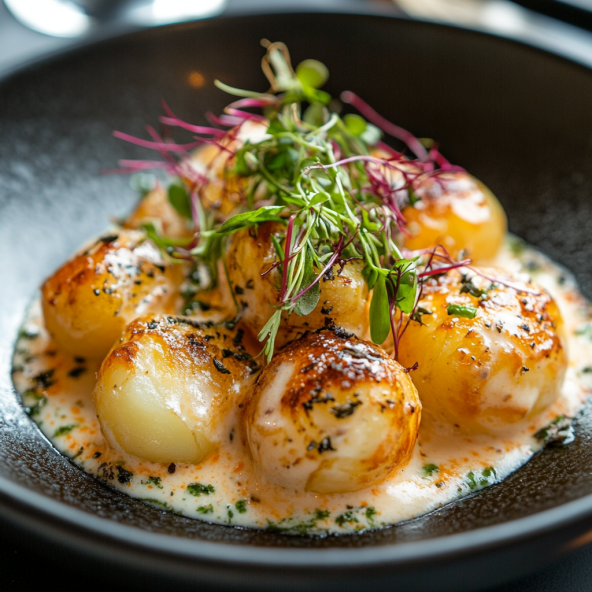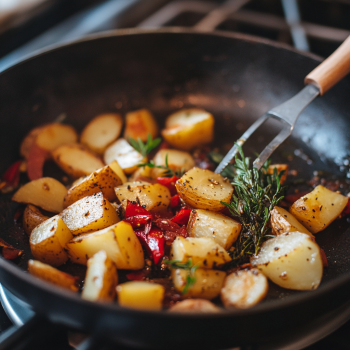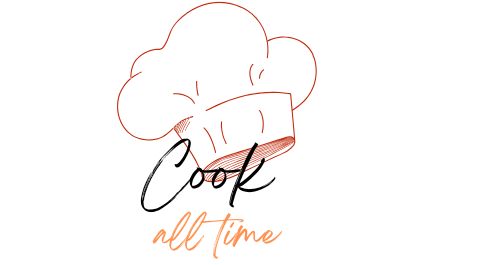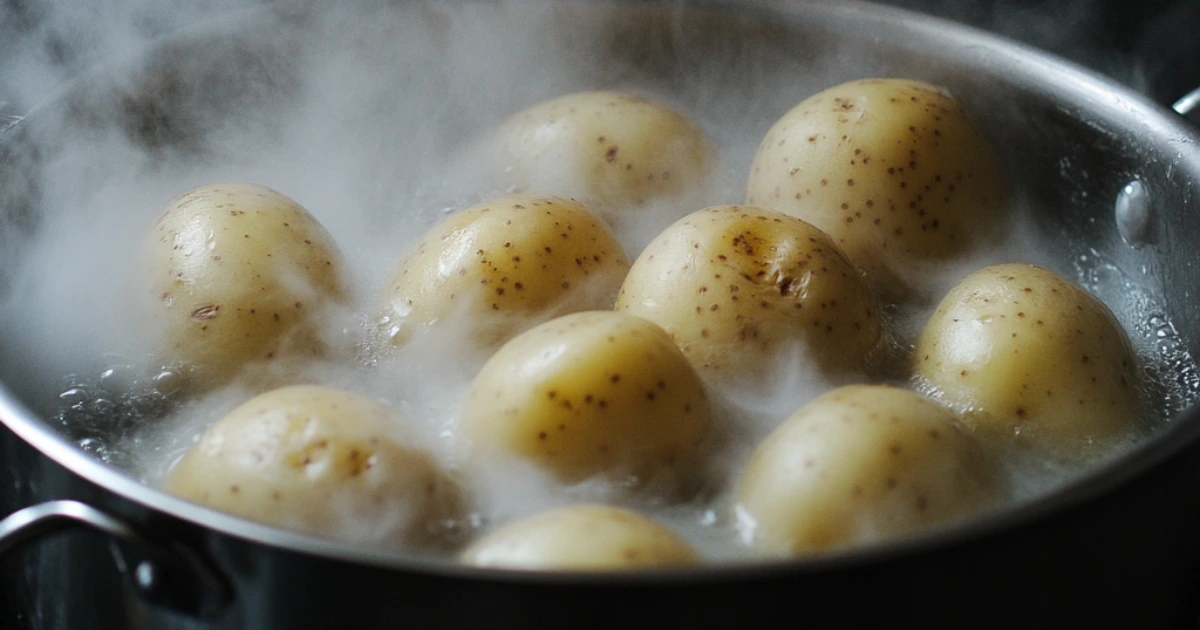Introduction
When it comes to making perfect mashed potatoes, the question of “Do you boil potatoes covered or uncovered for mashed potatoes?” often arises. This seemingly small detail can have a big impact on the texture and flavor of your final dish. While there are many factors to consider, understanding the science behind boiling methods and selecting the right potatoes is key to achieving creamy, lump-free mashed potatoes every time.
In this guide, we’ll break down the essential steps—from choosing the right potatoes to boiling techniques—and explain how the cooking method affects the final result. By the end, you’ll have a clear understanding of whether to boil your potatoes covered or uncovered and how to adjust your approach for the best possible mashed potatoes.
Table of Contents
Understanding the Science of Boiling
The science of boiling potatoes is all about heat transfer and moisture retention. Potatoes are made up mostly of starch, which can absorb water during cooking. The method you choose—covered or uncovered—will affect how the water is absorbed and how much moisture remains in the potatoes, both of which contribute to the final texture of your mashed potatoes.
- Starch gelatinization is key in turning potatoes from firm to soft, making them ideal for mashing.
- When potatoes are boiled with the skin on, they retain more flavor and nutrients, as the skin acts as a barrier.
- The cooking method also affects the texture of the potato flesh—over-boiling can make potatoes too watery, while under-boiling can leave them too firm.
Therefore, the method of boiling—covered or uncovered—will influence how well the starches cook and how much water the potatoes absorb, ultimately impacting the creaminess of your mashed potatoes.
Choosing the Right Potatoes for Covered or Uncovered
One of the first steps in preparing mashed potatoes is choosing the right variety. Potatoes come in many types, but waxy and starchy potatoes are the most commonly used for mashed potatoes. Each type offers distinct characteristics that can impact the texture of your dish.
- Waxy potatoes: These include varieties like Red Bliss and New Potatoes. They have a lower starch content and a higher moisture content, making them ideal for dishes like potato salad, but they may not create the fluffiness you want in mashed potatoes.
- Starchy potatoes: Russet potatoes are the go-to for mashed potatoes because they contain high levels of starch. Their texture becomes light and fluffy when mashed, making them the perfect choice for achieving smooth mashed potatoes.
For mashed potatoes, it’s generally recommended to choose starchy potatoes like Russets, as they will give you the creamy, light texture you’re aiming for.
Differences Between Waxy and Starchy Potatoes
The differences between waxy and starchy potatoes go beyond just texture. These variations can influence your decision on whether to boil potatoes covered or uncovered for mashed potatoes.
- Waxy potatoes: These potatoes tend to hold their shape better when boiled, which is why they are favored for recipes where you want potatoes to maintain their form. However, they can become a bit dense and less creamy if used for mashed potatoes.

- Starchy potatoes: When boiled, starchy potatoes break down more easily and absorb more water, making them perfect for mashing. They tend to become light and fluffy when prepared correctly, which is why they are typically preferred for mashed potatoes.
Understanding the differences between these potato types will help you decide the best boiling method, especially when considering how moisture and starch interact during cooking.
Preparing Potatoes for Boiling (Covered or Uncovered)
Before you even begin thinking about the method you’ll use to boil your potatoes, it’s important to prepare them properly. Proper preparation will ensure your mashed potatoes are smooth and creamy, not lumpy or watery.
- Peeling: While some people prefer to leave the skins on, peeling your potatoes can result in smoother mashed potatoes. However, if you choose to leave the skin on, make sure to wash them thoroughly to remove any dirt.
- Cutting: Cutting your potatoes into uniform pieces ensures even cooking. The pieces should be about 1-2 inches in size. This helps them cook faster and more evenly.
- Washing: After peeling and cutting, rinse the potatoes under cold water to remove any excess starch. This will help prevent the potatoes from becoming too gummy when mashed.
By following these simple steps, you’ll set the stage for a better boiling process, whether you decide to boil your potatoes covered or uncovered.
Want a quick solution? Learn how to cook Bob Evans mashed potatoes using quick and easy methods to save time without compromising flavor.
Boiling Potatoes Covered or Uncovered Techniques
When it comes to boiling potatoes for mashed potatoes, there are two main methods: boiling potatoes covered and boiling them uncovered. The decision you make will affect both the texture and consistency of your mashed potatoes. Let’s dive into each method and explore the pros and cons.
Covered Boiling Method
The covered boiling method involves placing the potatoes in a pot with water and covering it with a lid while it simmers. This approach is often preferred for those who want to retain as much moisture and heat as possible during the cooking process.
- The covered method allows the water to come to a boil more quickly and helps maintain a constant temperature.
- It traps heat and moisture, which can result in creamier mashed potatoes as the potatoes absorb more water.
- This method works particularly well with starchy potatoes, as it allows them to become soft without drying out.
However, it’s important not to overboil the potatoes, as excessive moisture can cause them to become too watery and difficult to mash.
Uncovered Boiling Method
The uncovered boiling method involves leaving the pot open, allowing the water to evaporate more freely during cooking. This approach is generally used when you want to control the amount of moisture in your potatoes.
- Boiling potatoes uncovered allows some of the water to evaporate, which may help prevent potatoes from becoming too watery.
- This method is beneficial for waxy potatoes that don’t absorb as much water, but it requires more attention to prevent the potatoes from drying out.
- It can take longer for the water to come to a boil without the lid, which may slow down the cooking process.
Why Boiling Covered Matters
You might be wondering why boiling potatoes covered is often the preferred method for mashed potatoes. There are several important benefits to this approach, particularly when it comes to preserving heat and moisture.
- Conserving heat: The lid traps heat inside the pot, helping the water come to a boil faster and keeping the potatoes at a consistent temperature throughout the cooking process. This can lead to a more even cook and prevent any parts of the potatoes from being undercooked.
- Retaining moisture: With the lid on, moisture is less likely to evaporate, meaning the potatoes won’t dry out as much. This is especially important for achieving a smooth, creamy texture when mashing.
- Better texture: By maintaining consistent heat and moisture, boiling potatoes covered helps achieve a fluffy and creamy texture that makes for perfect mashed potatoes.
For these reasons, most chefs and home cooks prefer boiling potatoes covered when preparing mashed potatoes.
Drawbacks of Boiling Potatoes Covered
While boiling potatoes covered has its advantages, there are also some potential drawbacks to consider.
- Longer cooking time: If you are boiling potatoes with the lid on, you might not notice when the water has reached a rolling boil. This can sometimes result in overcooking the potatoes.
- Risk of over-boiling: The potatoes can easily overcook if left too long with the lid on, making them soggy or waterlogged. Overcooked potatoes will be more difficult to mash and can lead to a gluey texture.
- Less control over moisture: With the lid on, it’s harder to monitor how much moisture the potatoes are absorbing, which can lead to overly wet mashed potatoes if you’re not careful.
To avoid these issues, it’s important to keep an eye on the cooking process and test the potatoes regularly to ensure they reach the desired softness without overcooking.
Uncovered Boiling Benefits
While boiling potatoes covered is typically the go-to method for mashed potatoes, there are some distinct benefits to boiling them uncovered, particularly if you’re looking to control moisture levels more precisely.
- Faster cooking: Without the lid, the water comes to a boil faster. This can save time, especially if you’re in a rush to make mashed potatoes.
- Less risk of sogginess: Boiling uncovered allows some moisture to evaporate, reducing the risk of the potatoes becoming too waterlogged. This is especially useful if you’re using waxy potatoes or want to maintain more control over the water content in your mashed potatoes.
- Easier to monitor doneness: Without a lid, you can check the boiling process more frequently, making it easier to avoid overcooking the potatoes.
While this method requires a bit more attention, it can lead to mashed potatoes that are not too watery and have the right balance of texture and creaminess.
How to Test Doneness
When it comes to making mashed potatoes, testing for doneness is crucial. Overcooked potatoes can become mushy and waterlogged, while undercooked potatoes will be hard to mash. So, how do you know when they’re ready?
To test doneness, insert a fork or knife into the center of a potato piece. If it slides in easily with little resistance, your potatoes are cooked through. Here are a few tips to ensure the perfect doneness:
- Softness: Potatoes should feel tender but not falling apart.
- Even cooking: Make sure all potato pieces are cooked evenly. Smaller pieces cook faster, so it’s important to cut them uniformly.
- Boiling method: If you’re wondering, “Do you boil potatoes covered or uncovered for mashed potatoes?” boiling covered tends to create more even cooking, especially for larger pieces.
By testing for doneness correctly, you’ll avoid the common pitfall of having too-soft or too-firm potatoes.
Draining Potatoes Properly
Once your potatoes are boiled and tender, it’s time to drain them. Proper drainage ensures you don’t end up with excess water in your mashed potatoes, which can lead to a watery or gluey texture.
- Use a colander: After boiling, pour your potatoes into a colander and let them sit for a few minutes to drain off any residual water.
- Avoid over-draining: While it’s important to remove excess water, you want to retain a bit of steam in the potatoes to help with mashing.
- Dry them slightly: Gently shake the colander or return the potatoes to the pot for a brief moment to let excess moisture evaporate.
By ensuring that your potatoes are drained properly, you can create fluffy, smooth mashed potatoes without any unwanted water.
Mashing Techniques for potatoes covered or uncovered
When it comes to mashing your potatoes, the technique you use can drastically affect the texture of your final dish. Whether you’re wondering “Do you boil potatoes covered or uncovered for mashed potatoes?” or focusing on mashing itself, here are some tips to achieve the best results:
- Use the right tools: A potato masher is ideal for a slightly rustic texture, while a potato ricer or food mill gives a smooth and creamy finish.
- Mash while hot: Potatoes mash best when they’re still warm, as they absorb ingredients like butter and milk more efficiently.
- Don’t overwork: Over-mashing can cause the potatoes to become gummy. Mash just enough to reach your desired consistency.
Mastering your mashing technique will result in potatoes that are creamy, light, and free of lumps.
Adding Flavors for potatoes covered or uncovered
Adding flavor to your mashed potatoes is an art in itself. The ingredients you choose can elevate your dish from basic to extraordinary. Here are some flavor ideas to consider:

- Butter and cream: These are the foundation of many mashed potato recipes. Butter adds richness, while cream gives a smooth texture.
- Garlic: Roasted garlic or garlic powder can lend a savory depth to your potatoes.
- Cheese: For extra creaminess, incorporate shredded cheddar, parmesan, or cream cheese.
- Herbs: Fresh parsley, chives, or thyme can add a burst of flavor and color.
- Sour cream: For a tangy twist, consider adding sour cream to your mashed potatoes.
Remember, seasoning your potatoes with salt and pepper is also essential to balance out the richness of the other ingredients.
Common Mistakes to Avoid
Achieving the perfect mashed potatoes can be tricky, and there are several common mistakes that can affect the outcome. By being aware of these, you can ensure your potatoes come out just right.
- Using the wrong potatoes: As discussed earlier, using waxy potatoes can result in dense, unfluffy mashed potatoes. Stick with starchy varieties like Russets for best results.
- Boiling potatoes uncovered for too long: This can lead to evaporation and a dry texture. Consider the method: “Do you boil potatoes covered or uncovered for mashed potatoes?”—covered is often the best way to ensure a moist texture.
- Over-mashing: Overworking potatoes can release too much starch, resulting in a gluey consistency.
- Not draining well enough: Excess water can make your mashed potatoes runny and difficult to season.
By avoiding these common mistakes, you can ensure that your mashed potatoes are smooth, creamy, and perfectly seasoned.
Alternative Cooking Methods: Steaming, Pressure Cooking, and Microwaving Potatoes
While boiling is the most common method for preparing potatoes for mashing, there are several alternative cooking techniques that may offer benefits in terms of time, texture, and convenience.
- Steaming: Steaming potatoes preserves more nutrients and can give you slightly drier potatoes, which are easier to mash. It’s an excellent option if you want to avoid excess water.
- Pressure cooking: A pressure cooker can cook potatoes quickly and evenly. This method is perfect for those in a rush, but keep in mind that the texture may be slightly different from boiling.
- Microwaving: If you’re short on time, microwaving is the quickest method. Simply microwave your potatoes in a covered dish for about 5-10 minutes. While it can be a convenient method, it may not yield the same creamy consistency as other methods.
Each of these alternatives has its pros and cons, so experiment to find the method that works best for your mashed potato preferences.
FAQs
1. Do you boil potatoes covered or uncovered for mashed potatoes?
When boiling potatoes for mashed potatoes, it’s generally better to boil them covered. This helps maintain heat and moisture, which results in evenly cooked potatoes that are easier to mash.
2. Can I leave the skin on when making mashed potatoes?
Yes, you can leave the skin on if you prefer a more rustic mash. Just make sure to scrub the potatoes well to remove any dirt or debris.
3. How can I make my mashed potatoes creamy?
For creamy mashed potatoes, use a potato ricer or food mill, mash the potatoes while they are still warm, and add butter, cream, or sour cream to enrich the texture.
4. What are the best potatoes for mashed potatoes?
The best potatoes for mashed potatoes are starchy varieties, such as Russets. These potatoes break down easily and create a fluffy texture when mashed.
Conclusion
In conclusion , In the end, making perfect mashed potatoes boils down to several key factors: the type of potatoes you choose, the cooking method you employ, and how you mash them. The common question “Do you boil potatoes covered or uncovered for mashed potatoes?” has a straightforward answer: boiling covered generally leads to better moisture retention and more evenly cooked potatoes.
By understanding the science of potato preparation, testing for doneness, and avoiding common mistakes, you can achieve creamy, smooth mashed potatoes every time. Don’t forget to experiment with alternative cooking methods like steaming or pressure cooking for added convenience, and feel free to get creative with your seasonings and flavor additions. Whether you’re making mashed potatoes for a holiday feast or a weeknight dinner, the right techniques will ensure your dish is a success.


3 thoughts on “Do You Boil Potatoes Covered or Uncovered for Mashed Potatoes? The Best Method Explained”